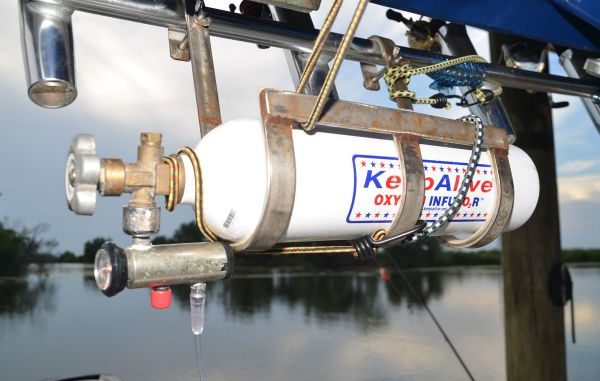
Having live bait can make the difference in having a successful trip. Live bait is also expensive.
When live bait dies, both the trip and a lot of money can go out the window.
So Capt. Rykert Toledano combines three elements in his approach to taking care of his bait: adding new water, recirculating water and adding oxygen.
Toledano only takes new water into the bait tank from outside the boat occasionally to flush the system, preferring to use his KeepAlive recirculating pump to move water from the tank and add it back to add millions of tiny bubbles produced through the “venturi effect.”
He cautioned not to add new water to the tank when the boat is in an area of freshwater, as low salinities will kill shrimp.
He also adds pure oxygen directly to the water of the tank with a KeepAlive Oxygen Infusor. Hospital oxygen hose pipes the oxygen from the tank Toledano has hung on his boat’s T-Top. The hose ends in a diffuser stone that has suction cups that keep it positioned on the bottom of the tank.
The oxygen leaving the stone comes out in very, very tiny micro bubbles, but shrimp in the tank immediately congregate around the stone.
The KeepAlive oxygen system comes with a regulator that meters the amount of oxygen discharged and displays how much oxygen is left in the tank. Tank refills can be made at welding supply houses.
Settings range from 1/64 to 1.0. Toledano usually sets it at 1/8 at the beginning of a night trip and then decreases it to 1/16 or 1/32. During the day in the summer, he runs it at 1/8 to 1/16.
KeepAlive Oxygen Infusor systems can be purchased at local sporting goods stores in Louisiana or from the Internet, Toledano noted.
Expect to pay between $300 and $400.
Toledano has one more live bait trick up his sleeve.
Before he starts a trip, he adds a couple of frozen reusable FreezPaks. Cool water holds more dissolved oxygen than warm water because of the chemical nature of water.
“Milk jugs of frozen water don’t work as well,” he noted. “They often get holes and the freshwater from inside the jug leaks out and dilutes the salinity of the tank’s water.